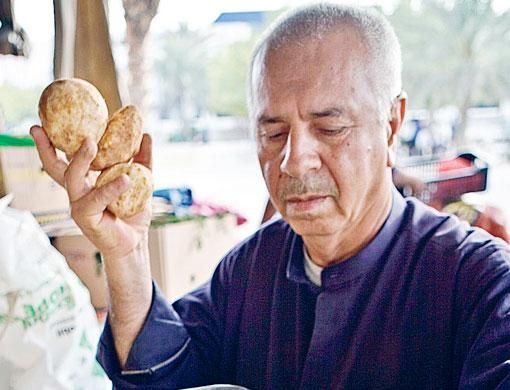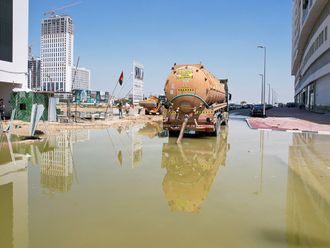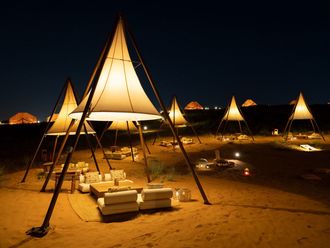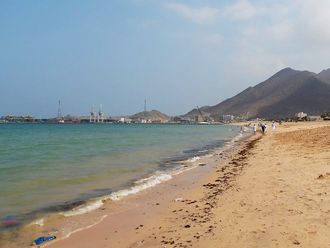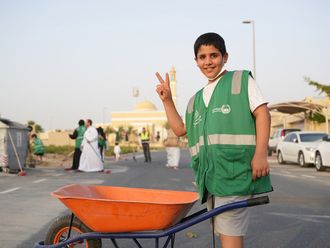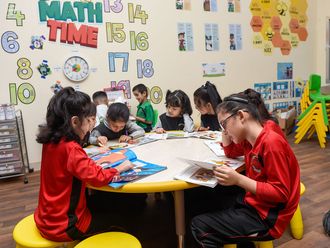Dubai: According to recipe books and researchers alike, desert truffles appear after a good rain and especially after a thunderstorm. Legend has it that wild desert storms are at the root of the truffle, and the wilder the storm, the more abundant the truffles.
Cooks familiar with truffles from the Middle East claim those found in the Gulf originate from the Syrian desert near the ancient site of Palmyra. Truffles vary either black or white, pink or red but the darker is most sought after.
Old prunes, gnarled potatoes, or mere mushrooms - all of these are insults to the desert truffle. Enthusiasts often pay up to Dh180 per kilo for the truffles. There are around 30 varieties found throughout the Middle East, ranging from the size of a plum to the size of your fist. Desert truffles sprout up around the Mediterranean, along the North African coast from Morocco to Egypt, and from Damascus in Syria to Basra in Iraq.
Also known as kama, kamaieh or fagga, truffles in the UAE can sometimes still be found towards Wadi Helio, under the shade of a bush called Helianthemum according to some environmentalists.
Development has taken its toll on truffles with the best-known areas in Dubai where truffles were commonly found, now gone, said Dr Reza Khan, Dubai Zoo director and avid botanist. According to Khan, the biggest mystery around the vegetable is that they only seem to grow in the wild.
"You used to be able to find truffles after a rain from Al Sufouh to Jebel Ali. The plant grows year-round but only a good rain will produce truffles," he said.
"Families will have their preferred areas to find them but these are becoming less and less."
At the Fruit and Vegetable Market in Dubai, one of the few markets to sell the delicacies, the white and pink variety can be found - but only at two stalls. Vendors tend to specialise in fruits and vegetables either from India or Africa.
Hassan from Iran, who mans a corner stall, has these two varieties. Covered by mesh in a red crate under rows of courgettes and aubergines, the truffles are stored on the ground - sought by mostly Emirati families and Arabs from the region.
"These fagga are from Saudi Arabia," he says. The delicate cargo is flown in most days as truffles decay fast. Hassan says the bulk of his customer base is Arab. Almost on cue, a tall Arab man with chequered gutra grabs handfuls of fagga, weighing them up in his hand and observing them. He hurriedly carts off three crates but not before telling me of the benefits. "They come with the rains and they are good for health. They taste very good," he said.
According to John Feeney, a New Zealand filmmaker who researched desert truffles during his 40 year tenure as a resident in the Middle East, the charm of fagga is their look, "Wrinkled and gnarled when dug up, and slightly perfumed, they look for all the world like bruised, lobed potatoes, wizened walnuts or dried prunes. Their appearance is of course deceptive-part of the mystique."
Feeney died in 2006 but had spent a number of years in Egypt. He wrote: "In the Eastern Province of Saudi Arabia, where they are found mainly between Nu'ayriyah and Qaysumah, and also near Safaniya, local names are also used, and two varieties are best-known: khalasi are oval with a black skin and a pinkish-ivory interior, and have a nut-like flavour that many think makes them the very best. However, after years of enjoying many varieties of Saudi truffles, I favour the second major type, the cream-coloured zubaydi, which is usually more expensive, but which offers a more delicate flavor."
Researchers found that as little as 200 to 250 millimeters of rain can produce a good crop, wrote Feeney. Too much rain can rot the truffle spores. Then the weather must remain dry during January, followed by a light shower or two in the spring to bring on the truffles in February and March.
Quick tips: Cooking faggaFagga or kama are usually full of sand and must be diligently cleaned. First soak in cold water for two hours. Then scrub with a hard bristled brush, rinse, and remove the thin layer of outside peeling with a sharp knife. Go over them carefully, prying out any sand remaining in the cracks with the tip of a knife. Wash in several waters. Now the truffles are ready for cooking.
(Source: Food from the Arab World by Marie Karam Khayat and Margaret Clark Keatinge, Khayat's, Beirut 1959)


